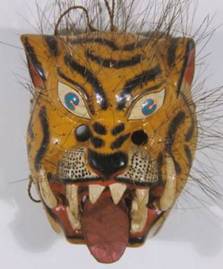Máscaras (1994)
For Cello and Orchestra
Piano reduction available
Duration: 18 minutes
Cello; 2(pic)2(ca)2(Ebcl,bcl)2/2210/timp.2perc/hp.pf/str
Commissioned by Carlos Prieto
Premiere Performance: October 22, 1994; Orquesta de la Festival International Cervantino; Carlos Prieto, cello; Guido Guida, Conductor
Traditional Mexican Mask
Máscaras was inspired by the richly decorated masks used in traditional Mexican folk dances. The work is intended for performance either as a concert piece or a ballet. The music of Máscaras has a strong Mexican flavor and has woven into its texture two Mexican folk melodies – El Tecolote (The Owl) and El Tigre (The Jaguar).
Program Note:
Máscaras is Rodríguez’ third string concerto. Like its predecessors, Favola Concertante and Ursa, Máscaras is programmatic. Rodríguez has based Máscaras upon the richly decorated masks used in traditional Mexican folk dances and has intended his work for performances either as a concert piece or as a ballet.
There are six short movements in place of the usual three. The first, Evocación, is a florid and passionate incantation for the solo cello over a hypnotic ostinato accompaniment. The second movement, El Murciélago (The Bat), is a high-strung scherzo in which the solo cello literally takes off like the proverbial “Bat out of Hell” in this depiction of one of Mexico’s most popular masks, the messenger of death. La sirena y El Tecolote is a mock-serious pair of lyrical cello serenades. La Sirena, iridescently chromatic, depicts a seductive mermaid (and perhaps Cortez’ native mistress, Malinche, the subject of many Indian masks) followed by El Tecolote, a buffo pizzicato depiction of another Aztec harbinger of death, the owl. The incongruous pairing of the owl and the mermaid recalls Edward Lear’s nonsense poem The Owl and the Pussycat; here the owl’s serenade is cut short by Compañeros de la Oscuridad (Companions of the Darkness). This fourth movement is likewise both playful and phantasmic, as piercing tone clusters of Bartokian “night music” usher in a gallery of intricately grotesque Indian monster masks: serpents, lizards, scorpions, toads, devils, skeletons and bearded (European) men. After the night creatures pass, the owl and the mermaid calmly continue their serenade. The fifth movement, El Angel, provides radiant contrast as high rushing European scales in bells and harp depict the familiar winged, fair-skinned Christian image. The work ends with El Tigre, a festive toccata in which brilliant cello passage work depicts the jaguar: in Indian legends the king of beasts and the embodiment of the powerful human vs. animal duality believed to exist within each individual.
The music of Máscaras has a strong Mexican flavor. Like Rodríguez’ two best-known operas, Monkey See, Monkey Do and Frida: The Story of Frida Kahlo, Máscaras contains actual Mexican folk melodies – in this case, “El Tecolote” (the owl) and “El Tigre” (the jaguar) – woven into the musical texture. Since many of Mexico’s folk mask pre-date Cortez, Rodríguez has created musical echoes of Aztec Mexico with non-Western modal motifs drawn from the tuning of ancient flutes and punctuated by sharp, irregular rhythmic accents and a storehouse of colorful Latin timbres. Three typically Indian sounds predominate, all created with modern orchestral equivalents to, or in come cases descendants of, their ancient originals: woodwinds (in imitation of reed flutes), percussion (with particular emphasis upon woods such as temple blocks and marimba) and brass (opening, in the Evocación, with an off-stage French horn in imitation of the traditional caracól, a conch shell blown as a ceremonial trumpet).
In depicting masks which incorporate European-inspired images, Rodríguez has employed sly musical quotations from Mexico’s Spanish and Austrian conquerors. Joining the Compañeros de la Oscuridad are another celebrated nocturnal pair, La Maja y El Ruiseñor (The Maiden and the Nightingale), represented by a melody from Enrique Granados’ opera, Goyescas, based on paintings by Francisco Goya. Another Spanish quotation appears in El Angel, which is based on the celebrated 100th Cantiga, or hymn to the Virgin Mary, of the 13th-Century Castilian king, Alfonso, El Sabio (The Wise).
Similarly, two of the Emperor Maximilian’s Viennese compatriots are represented. El Murciélago features several wittily disguised gragments from Johann Strauss’ comic operetta, Die Fledermaus, while Compañeros de la Oscuridad tweaks the Emperor’s blond beard in ¾ time for the appearance of the Barbones (bearded men), who are accompanied by the scherzo from Franz Schubert’s B-flat Major Piano Sonata, Opus Posthumous. The Schubert is itself irreverently superimposed over the folk song El Tecolote, as well as over Rodríguez’ own siren music (perhaps suggestive of the Empress Carlotta). All of these quotations and disparate musical allusions are elegantly fused in Rodríguez’ characteristic “richly lyrical atonality” (Musical America) in a style “Romantically dramatic” (The Washington Post) and filled with the composer’s “all-encompassing sense of humor” (The Los Angeles Times).